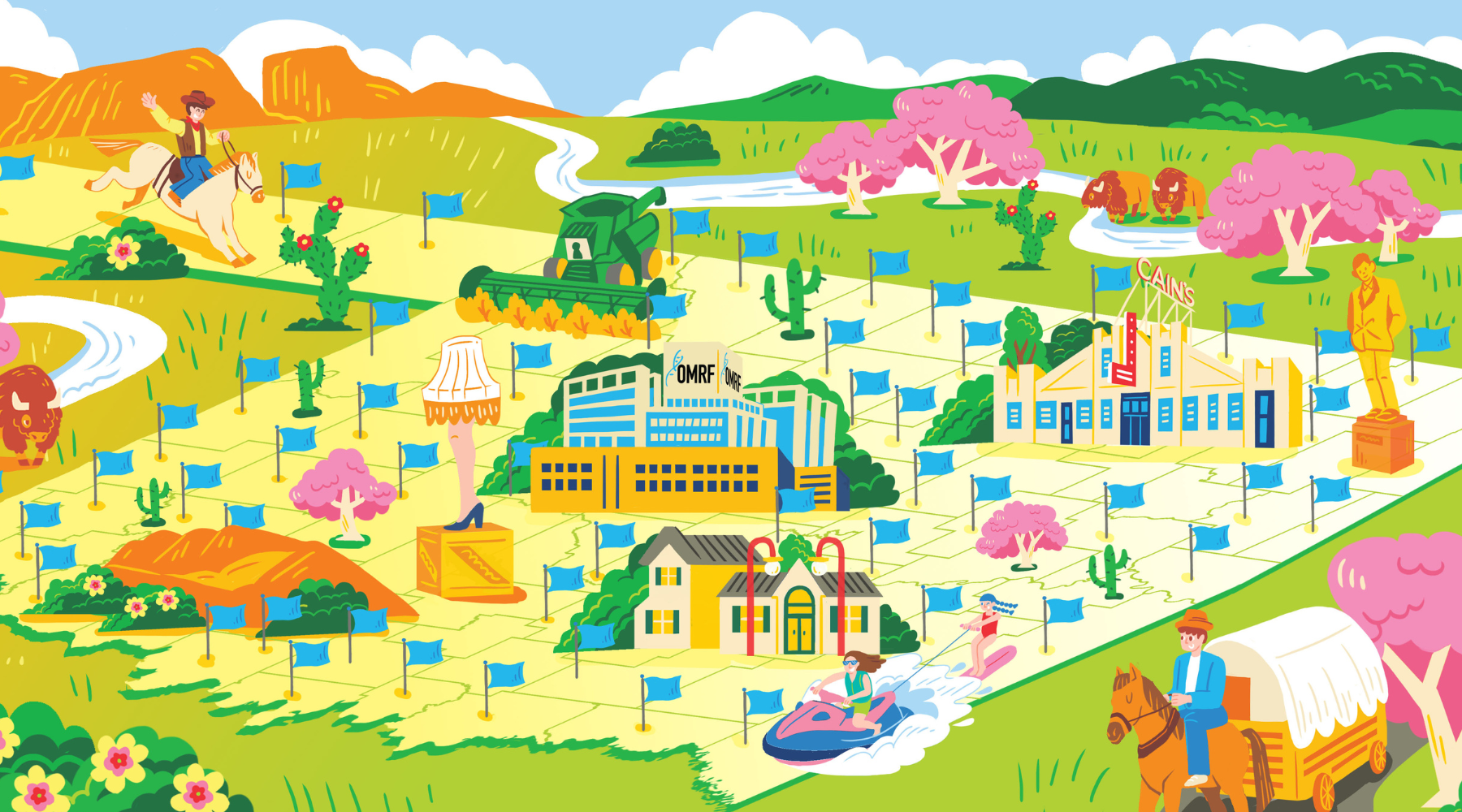By Adam Cohen
OMRF marked its 77th birthday with a statewide gratitude tour
Dr. Andy Weyrich stood up in front of the crowd that had gathered at Pete’s Place, an Italian restaurant on the outskirts of McAlester, Oklahoma.
“Why are we here?” the president of the Oklahoma Medical Research Foundation asked. The audience was silent, save for the clinking of a few pieces of silverware as people put down their forks and knives to listen.
Weyrich, wearing a pair of khakis and an OMRF polo shirt, took a few steps away from where he’d been seated. He extended his arms, palms raised, and cocked his head to the side. “What’s the story behind this?”
Again, nothing.
Perhaps it had been this way 77 years earlier. In 1947, Gov. Roy J. Turner declared a statewide research week, and a dozen nationally prominent scientists from institutions like the Mayo Clinic and Rockefeller University were dispatched throughout the state. Their charge: to advocate for the creation of a new medical research foundation in Oklahoma.
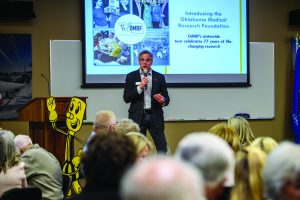
Over the course of seven days in May, the scientists and other advocates crisscrossed Oklahoma in Edsels and Hudsons, holding 137 meetings in 42 cities. In auditoriums and banquet halls, they sketched pictures of an institute that would, in the words of its founding documents, conduct “scientific investigations in the field of medical research to attack killing and crippling diseases about which little is known by science.”
How had the audiences reacted to this ambitious vision? Perhaps they’d risen to their feet and cheered. Or maybe they’d peppered speakers with skeptical questions. But, most likely, just like the group assembled that evening in Pittsburg County to hear Weyrich, they’d started out quiet. Listening. Wanting to understand. To learn and process.
If they had reactions, those would come later. After they’d had a chance to digest the presentation.
Unlike his forebears in 1947, though, Weyrich wasn’t painting a portrait of some theoretical institute. No, in 2024, he was talking facts. History. Concrete accomplishments.
You see, those first meetings planted the seeds for a statewide fundraising drive. And even though the concept of building a research institute from scratch might have been, as Weyrich told the crowd at Pete’s that night, “a hail Mary,” it resonated with Oklahomans.
They gave $2 million, and OMRF was born.
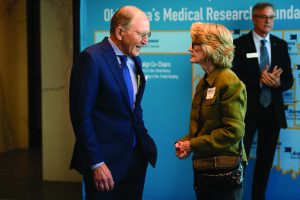
Seventy-seven years later, the foundation has achieved breakthroughs its founders couldn’t have imagined. Life-saving medications for rare blood disorders. The first therapy approved by the Food and Drug Administration for the pain crises in sickle cell disease. Discoveries that have transformed the treatment landscape for HIV/AIDS, rheumatoid arthritis and lupus.
Weyrich would detail all of this and more in his presentation that night. And the folks who’d come to see him would ask plenty of questions and say plenty of nice things about OMRF. But before all that, OMRF’s president would start by answering the questions he’d posed.
What was he doing in Krebs?
“Really,” he told the audience, “it’s pretty simple.” He grinned. “This is a gratitude tour. We’re here to thank you.”
That gratitude tour kicked off on Aug. 28, 2023, the 77th anniversary of OMRF’s founding. In OMRF’s Gaylord Pavilion, 300 or so friends and supporters of the foundation gathered to launch the initiative. In front of a massive state map, Weyrich detailed the plan.
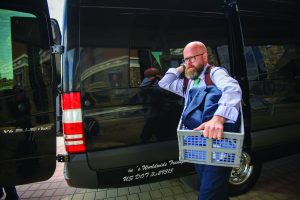
Weyrich and the OMRF team had broken the state into 25 districts, which mirrored the blueprint OMRF’s founders had drawn up in the initial fundraising campaign in the 1940s. For this 77th anniversary tour, Weyrich explained, OMRF would host events in 25 “focus” cities, one located in each district. Along the way, Weyrich would touch down in all 77 of the state’s counties.
The effort, which Weyrich dubbed “77 for 77,” was emphatically not a fundraiser. Invitations to events made clear that attendees should “leave [their] checkbooks at home.” Weyrich wanted only to acknowledge and thank the communities that had built OMRF. And he’d do so by going out into those very communities.
The first foray beyond Oklahoma City happened in September, in Woodward. Events in Duncan, Ardmore, Chickasha, Stillwater and Weatherford soon followed.
The team quickly established its routine. Vice President of Philanthropy & Community Relations Penny Voss and Vice President of Government Relations & Advocacy Lisa Day identified community members willing to serve as local chairs. Working with those chairs, as well as OMRF’s internal donor data, they’d put together an invitation list.
Meanwhile, members of OMRF’s Philanthropy team would go out into the community to select a venue. On the day of the event, they’d arrive – in cars or, if the crew was big enough, a rented sprinter van – hours beforehand to get the place ready. Some planted OMRF flags out front, while others set up inside: pop-up banners and registration tables stocked with guest lists, nametags and OMRF giveaways like lip balm and mints. They’d make sure the WiFi was enabled so people could don virtual reality goggles that allowed them to “tour” OMRF’s labs. And they’d get the audio and visual systems ready for presentations by Weyrich and OMRF scientists, who took turns making the trips from Oklahoma City so audiences could get a taste of the projects underway in the foundation’s labs and clinics.
By the time the road show arrived in Guymon a few weeks before Thanksgiving, says Voss, “We had it down.” Still, she was concerned. Guymon sits in Oklahoma’s Panhandle, 263 miles from OMRF. How interested would people be to learn about a research foundation a four-hour drive away?
She needn’t have worried. At the event, the Guymon district chair, Dr. Martin Bautista, kicked off the proceedings with a rousing rendition of “My Way,” the Frank Sinatra standard. And while he belted out the lines “Regrets, I’ve had a few,” Bautista certainly had none that evening. A gastroenterologist who’d been practicing in Texas County for more than a quarter century, he’d mustered a crowd that filled a local venue almost to overflow. They listened attentively as Weyrich said his thanks for all that Guymon residents had done to support the foundation and then to Dr. Bob Axtell, who explained how his lab at OMRF had made a series of new findings about multiple sclerosis and a related neurodegenerative disorder.
By the time the evening was done, Weyrich knew that he’d found someone special in Bautista. “We hoped 77 for 77 would help us identify some new friends and champions for OMRF,” he says. “The energy and enthusiasm that Dr. Bautista showed in putting together such a successful event just blew us away – especially when you consider that when he did that, he’d never even been to OMRF.” In May, Bautista joined the foundation’s Board of Directors. And that, he says, has provided him with a new mission: spreading the word about OMRF beyond the foundation’s Oklahoma City core.
“I want to help make the Panhandle aware that such a magnificent organization exists, and that it was built upon the grassroots efforts of Oklahomans,” Bautista says. “It deserves our attention and support.”
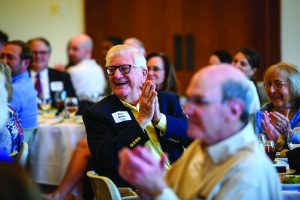
While Voss and her team devoted their energy to organizing get-togethers in 25 focus cities – events in which Weyrich played a central role – OMRF’s president mapped a course around the state heavy on two-lane highways and county courthouses. After all, he says, he’d named the campaign “77 for 77” for a reason. “That meant I needed to visit all 77 counties in Oklahoma,” he says. “No exceptions.”
Often, he and his family, who accompanied him, would take to the road both the day before and the day after a scheduled event. That would allow them to spend time in surrounding counties, where they enjoyed a mix of scheduled meetings and improvised stops. Whenever possible, the Weyrichs arranged to spend time with longtime OMRF supporters.
Some of the first donors they met this way were a mother and a daughter in Jefferson County, which sits on the state’s southern border. They’d first come into contact with OMRF in the 1980s, when a family member received care at OMRF and the neighboring Oklahoma City VA Medical Center, the daughter told Weyrich as he sat on their front porch. She called the experience “transformative,” says Weyrich. “It added years to his life.” They’ve given to OMRF ever since.
A bit to the north, in Murray County, the Weyrichs paid a visit to a local high school, where Andy had agreed to speak to a science class. He gave his spiel about OMRF, but, as teenagers are wont to do, the students grew restless. So, Andy’s wife, Amy, decided to change things up a bit.
Amy, an exercise physiologist, stepped to the front of the classroom and introduced their son, Sam, who lived with a rare genetic disease. She also introduced Baby G, who served as Sam’s service dog and constant companion.
Amy then proceeded to teach an impromptu lesson about service animals and the support they can provide. “The students loved it,” remembers Andy. And the best part? At the end of the session, Baby G went “off duty,” and the kids got a chance to pet the amiable black Labrador. “It definitely wasn’t your typical anatomy and physiology class,” says Andy.
For Amy – who, like Andy, is new to Oklahoma – the campaign offered the chance to get to know her new home state. It was an opportunity she wholeheartedly embraced.
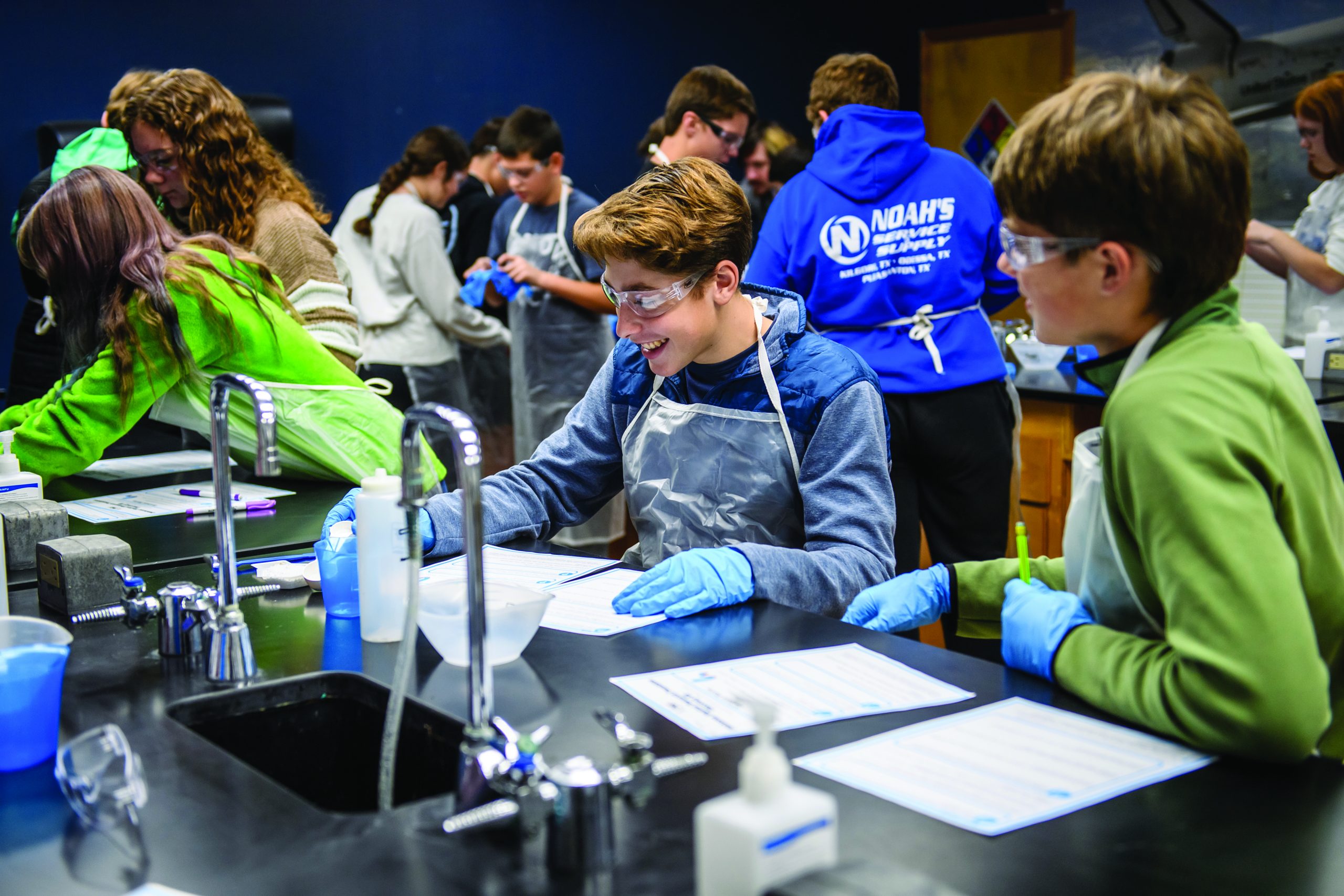
For Kim Henry, Oklahoma’s former First Lady and a co-chair of 77 for 77, the campaign offered more than a way to connect OMRF with communities around the state. It also presented a chance to promote science education in classrooms.
In partnership with the Sarkeys Foundation, where Henry serves as executive director, OMRF built an “experiment in a box” that it distributed over the past year to 217 seventh-grade classrooms across Oklahoma, including at least one in every focus city and in 74 of the state’s 77 counties.
Created by OMRF Vice President of Research Dr. Courtney Griffin and Sarah Specht, a science teacher at Marlow Middle School, the experiment involved making a substance essential to wound healing. For classrooms of 12- and 13-year-olds, it didn’t hurt that the compound had a consistency similar to gummy worms. “We identified seventh-grade students because they seem to be the right age to learn from and enjoy this experiment,” says OMRF Vice President of Vice President of Government Relations & Advocacy Lisa Day.
The project also paid small stipends to every science teacher who oversaw the experiment in their classes. The teachers, who completed surveys following the experiment, gave the experience uniformly high marks. “They all want to do it again,” says Day.
“I love to go to small towns, and I love to stay off highways, so it’s like a trip that was tailor-made for me,” she says. “It let me dive into the state’s history, too, and that’s been fantastic.”
The Weyrichs’ photo library is now filled with shots of them at local courthouses and historical societies, at diners and pharmacies. “My favorite stops are the ones that aren’t scheduled,” says Amy. “They’re the ones where we just walk into a place and strike up a conversation.”
One of those conversations took place in Sayre, when the Weyrichs stopped in to grab a cup of coffee on the heels of a visit to the Beckham County Courthouse. Andy began chatting with another patron in the coffee shop. It turns out the man had worked with OMRF years ago, when he’d trained as a first responder. Later, he’d gone into the funeral home business; he told Andy he’d always made it a point to recommend that, in lieu of flowers, people consider making a memorial donation to OMRF.
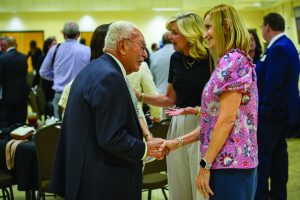
“It was the darnedest thing,” says Andy, shaking his head and smiling at the memory. “We were in this little coffee shop in western Oklahoma. And then, within a few minutes, everything had connected back through OMRF.”
The campaign paused over the winter holidays, then kicked back into gear the week after New Year’s in Miami. Events in Alva, Kingfisher, Muskogee, Bartlesville and Lawton soon followed. By the time Andy stood in front of the crowd at Pete’s Place, he and Amy had traveled nearly 8,000 miles. This presentation would mark his 23rd in a focus city, and the Weyrich family had by then visited all but a baker’s dozen of Oklahoma’s 77 counties.
You’d imagine so much driving, so many nights away from your own bed, that it would sap your energy. Make you eager to get back home. Back to your regular routine.
And sometimes, for Andy, it did. But just as often, when he was in Oklahoma City for a week or two, he’d find himself getting antsy. He’d envision loading up the family’s minivan for a three-day trip. Then hitting the road with Amy, Sam and Baby G.
The Weyrichs’ daughter, Sarah, even joined them on one leg of the trip. An actress, she was rehearsing to star in a production of “Oklahoma!” at a Michigan dinner theater. Thanks to 77 for 77, she got to visit a museum in Claremore dedicated to the state’s namesake musical.
For decades, Andy had spent the lion’s share of his life in a lab. Now, 77 for 77 had given him a chapter he’d never expected. A chance not only to explore his new home but to do so with the people he loved most. And the preciousness of that time would become even clearer when Sam unexpectedly passed away a few weeks shy of his 24th birthday.
The loss was devastating to the Weyrichs, but they took comfort in knowing Sam had reveled in nearly every moment of the experience. “Sam was game for anything,” Amy says. “So, traveling through Oklahoma for a year on an OMRF adventure was a dream job for him.”
Sam had a special connection with animals, especially horses. In Murray County, the family visited a ranch where wild mustangs roamed free. That night, remembers his father, “Sam was in heaven.”
Most of all, says Amy, “Sam liked any social situation. With 77 for 77, he got to meet so many people.”
Sam’s condition made eating extremely difficult, so his parents often had to supplement his meals with high-calorie liquids. The family’s journey through Oklahoma provided an unexpected way to do this.
Each day they were on the road, Andy and Amy would find a Sonic, a Braum’s or a local drugstore with a soda fountain. When their minivan came to a stop, Sam knew one of his very favorite treats would soon follow. His face would light up in anticipation of that chocolate malt.
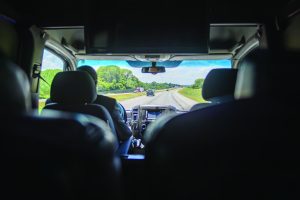
Throughout OMRF’s 77th year, each event in each focus city proved different. Crowd sizes ebbed and flowed, from packed halls to smaller groups gathered around a table or two. Venues had their idiosyncrasies. And no two OMRF presentations were the same. Sometimes, researchers described their work on lupus and autoimmune disease. Others counseled listeners about how to age healthily.
“We’ve had a lot of miles and a lot of smiles, all in the name of science,” says Dr. Courtney Montgomery, a Duncan native and OMRF data scientist who joined the campaign for several stops around the state.
At Pete’s Place, Dr. Patrick Gaffney talked about how genetic sequencing he’d conducted had alerted doctors to a cancerous tumor hidden in a teenager’s kidney. “We may have saved his life,” Gaffney explained to the audience.
Following the presentation, Dorothy Crone, a retired nurse and transplant patient, recounted how an OMRF physician-scientist had provided her with much-needed counsel during the pandemic. “I’m immunocompromised, and I was turning into the hermit of McAlester,” she said. But the guidance she’d received from OMRF’s Dr. Judith James helped her map a safe course forward, she said, “so, I finally was able to get out of my shelter at home.”
Although she’d never met James, Crone said, “I feel like I know her.” And, “When I saw OMRF was coming to Pittsburg County, I just knew I had to go.”
A few seats away, Dr. William Wynn nodded in agreement. A dentist, Wynn had come in late, delayed by work. But, he said, “This was too important for me to miss.”
Wynn had a friend and colleague, Dr. Greg Watkins, who also practiced dentistry in McAlester. Watkins’ life had been changed by a discovery at OMRF, a drug to treat the rare blood disorder that afflicted him. “Every day, I’d wake up and wonder, ‘How will I deal with the fatigue and pain? How will I make it through the day?’” remembers Watkins. In the 17 years since he’s been taking the drug, he says, “Those are no longer questions I ask myself.”
And so it seemed to go in every community OMRF visited. One way or another, the foundation had made a difference in the lives of the people who turned out.
Weyrich and his team had conceived of 77 for 77 as a way to say thank you to Oklahomans. And yet, those who came to the events often did so to say thank you to OMRF.
The campaign wrapped up in July, with an event at the headquarters of the Choctaw Nation in Durant, the 25th and final focus city. Technically, there remained a few loose ends to tie up. A reception to celebrate 77 for 77’s conclusion would take place the next month at the Oklahoma Historical Society in Oklahoma City. And before then, the Weyrichs would touch down in the last few of Oklahoma’s 77 counties they’d yet to visit.
It was a little after noon when the OMRF team climbed into the Durant-bound black sprinter van parked in front of the foundation’s main building on 13th Street in Oklahoma City. As they had for a year, Philanthropy staff members filled the back of the van with flags, a folding wagon, and a bevy of blue plastic tubs loaded with the equipment and materials they’d need once they’d made the 152-mile drive.
One OMRF staffer liked to joke that 77 for 77 had taught the group lots of skills they’d never use again. But Weyrich had recently decided the campaign had done such an effective job at building grassroots connections and support that he wanted to continue it beyond OMRF’s 77th year, with annual presentations rotating through different cities in the state’s four quadrants, plus yearly events in Oklahoma City and Tulsa.
OMRF’s president imagines this kind of robust and consistent outreach, especially to rural parts of the state, will pay untold dividends to the foundation over the coming years. The more people are exposed to OMRF, the more Weyrich hopes they’ll come to see the foundation like Kingfisher district chair Paul Schulte does.
“It doesn’t matter who you are politically,” Schulte said when he introduced Weyrich at a 77 for 77 stop in February. “OMRF buries the hatchet.” And with that, Schulte made a gesture as if he were interring an ax in the earth, where it would no longer serve as an implement of war. “OMRF just does what’s important to save lives.”
—
Read more from the Summer/Fall 2024 issue of Findings
